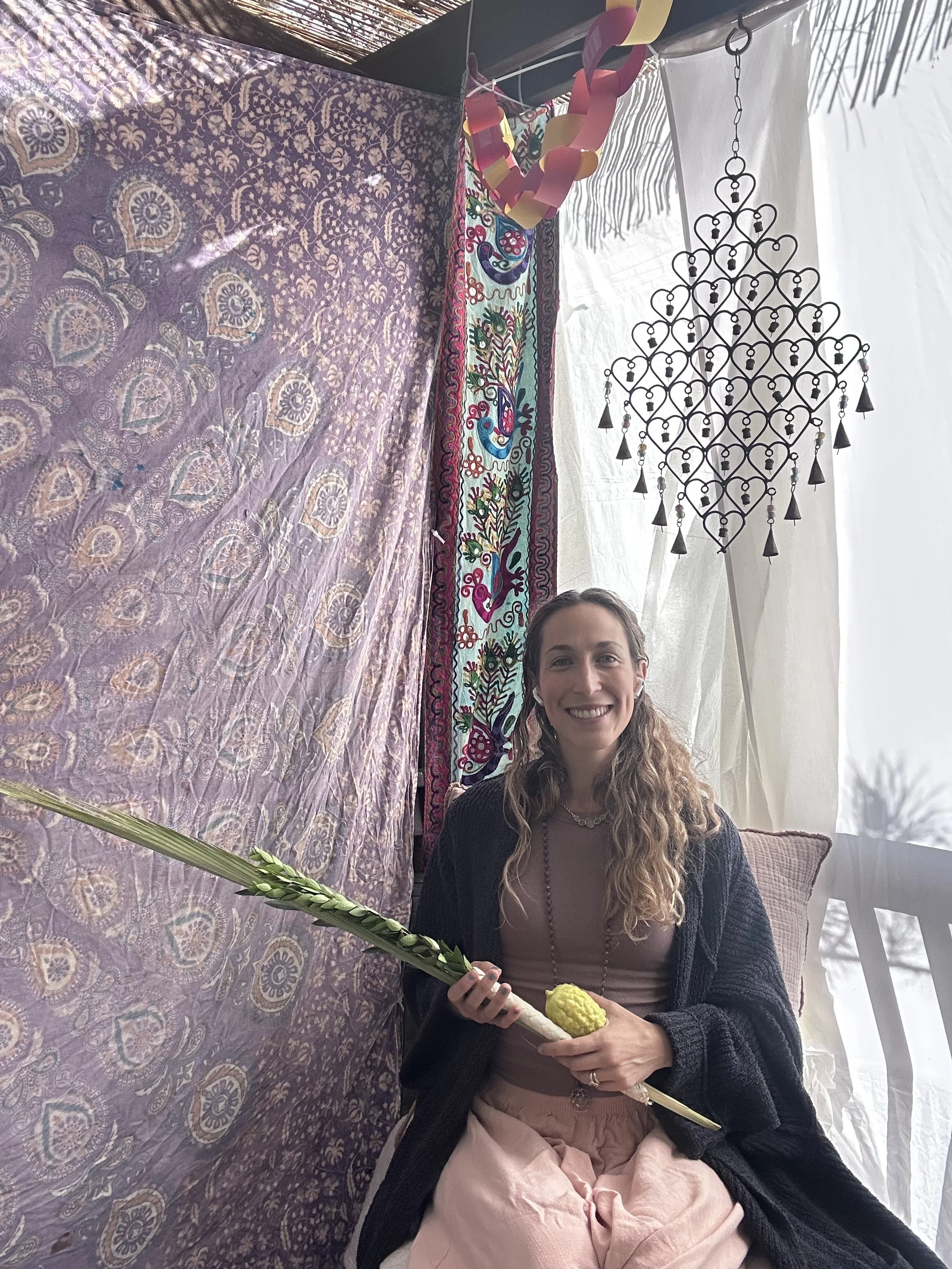Sukkot Ritual: Living in Divine Space
Living in Divine Space
By Jenna Zadaka, featured in At The Well’s Moon Manual for Tishrei
Although it isn’t the best known, to me the holiday of Sukkot is one of the most transformative and revealing — and one of the most embodied! Beginning at the full moon of Tishrei, for eight days we spend as much time as possible in a sukkah, a temporary shelter.
Whether we are eating, dancing, practicing yoga, painting, learning, or resting, the sukkah warmly envelops us in a divine hug, offering a sacred space for us to just be.
The great Kabbalist the Arizal taught that the requirements of a kosher sukkah — two whole connected walls and a small portion of a third wall — represent a divine embrace. The two full walls are an arm and a chest, and the small wall is the bent wrist hugging us.
When you imagine it like that, it’s clear that the sukkah is a physical representation of the romantic verse in Song of Songs, “His right hand embraced me” (8:3). The Divine presence surrounds and encompasses us, holding us intimately.
This immersive encounter with divine space cultivates a profound sense of presence and embodiment, challenging the linear, masculine perspective of "G-d Above, and Us Below." Instead, the sukkah symbolizes a feminine womb, surrounding us with divine presence from all directions — above, below, and all around. We encounter a state of wholeness in the sukkah, acknowledging the Source of Abundance that surrounds us.
Within the womb of the sukkah, there is an ancient ritual of sanctifying space with four sacred plants called the "Four Species," known as arba’ah minim in Hebrew. These include the lulav (branches of palm trees), etrog (citron), hadasim (myrtle branches), and aravot (willow branches) (Leviticus 23:40). Together, these four species represent a unity of physical and spiritual elements.
Each species corresponds to a specific part of our body:
Etrog (EH-trog): Resembling the shape of the heart, the citron symbolizes the power of the heart-space.
Lulav (LOO-lahv): With its resemblance to the long spine, the palm represents the structural support and flexibility that allow us to navigate life's transitions.
Hadasim (hah-dah-SEEM): The almond-shaped myrtle leaves mirror our eyes, inviting us to see and perceive the world with a loving gaze.
Aravot (ah-rah-VOTE): The willow leaves, resembling lips, remind us of the power of our words and prayers, and the ability to bring harmony through communication.
Bundling these "four species" together during Sukkot becomes an embodied practice of unifying and harmonizing all aspects of our being. The awareness of gathering parts of ourselves that can sometimes feel disconnected is a great way to begin the New Year from a place of wholeness.
This embodied practice will activate all four species in your body.
Embodying the Four Species
Supplies
Watch or timer
Comfortable seating
If you have access to a sukkah space, both of these rituals would be wonderful to do there! (Totally optional)
Steps
Lulav & Etrog Meditation
Set aside 5 minutes or so, and read this script aloud to your group:
Find a comfortable seated position, or any restful position that is comfortable for you. If it feels good, close your eyes or soften your gaze. Take a deep breath, then release. (pause)
Bring to mind the lulav, the palm, and its sturdy, upright structure. Feel the structure that your spine gives to you. Roll your shoulders up, back, and down to release tension.
When we “shake the lulav” on Sukkot, we are symbolizing flexibility in the spine, and flexibility to navigate life’s transitions in general. Take a few moments to explore gentle swaying, circular motions, twists, and spirals to loosen your spine. (pause)
Thank your spine for the length and flow it allows.
Now, bring to mind the vibrant yellow etrog, the citron, and its symbolism of the heart. Set your palms gently on your heart-space. Connect with the gentle rhythm of your heartbeat, a steady reminder of the life force within you. (pause)
Feel each heartbeat harmonize with your breath, drawing in the essence of Sukkot, a harvest festival of abundance, joy, and unity. (pause)
With each inhale, envision your heart filling with the overflowing blessings of Sukkot.
As you exhale, let this joyous energy radiate throughout your entire being. (pause)
With each breath, immerse yourself in the abundant joy and unity of Sukkot, unifying all parts of yourself in a harmonious embrace of wholeness and connection. (pause)
Now, take a moment to express gratitude for this experience of letting your heart’s joy guide you into the year ahead. With a final deep breath, allow your eyes to softly open.
Hadas & Arava Blessing Practice
In this brief partner meditation, find a partner and sit facing each other. Set a timer for 90 seconds, and enter into a silent, shared gaze. The almond shape of the myrtle leaves (hadasim) resembles an eye. Take this time to truly see and appreciate the goodness and beauty in each other. Look beyond external appearances, recognizing and acknowledging the unique qualities and positive aspects within your partner. Through this visualization practice, may you witness the divine spark within each other.
(If anyone in your group is visually impaired or blind, those partners can use this time to sit in silence together, energetically sensing each other’s divine spark and inner goodness.)
Once the 90 seconds are up, deepen this practice with a blessing. The willow leaves (aravot) resemble the lips. Offer your partner well-wishes with an intentional blessing. For example, “May you experience joy this Sukkot!” You can make these blessings as personal as you wish! Feel the joy in both giving, and receiving blessings.
Reflection Question:
Which elements of yourself (heart, spine, eyes, or lips) could use a fresh start in the year ahead? What actions can you take to renew this quality in yourself?


